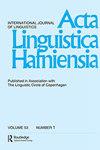Poor weak het ‘it’ and agreement patterns in pronominal clefts
Q2 Arts and Humanities
引用次数: 0
Abstract
ABSTRACT This paper proposes a novel analysis of the exceptional agreement patterns in pronominal het ‘it’-clefts with the order het-copula-pronoun in Dutch. We argue that the complex interaction in clefts between case, agreement and word order can be explained from the radical featural defectivity of het ‘it’: het ‘it’ has a third person (3p) feature, but no case, number, strength and gender features. We show that het ‘it’ is different from all personal pronouns in the major dialect groups of Dutch in that it never shows any case distinction. The absence of case on het ‘it’ makes it possible and necessary for the pronoun to occur in the nominative in a cleft. Similarly, the absence of number in the feature specification of het ‘it’ makes plural agreement with the pronoun possible and necessary in clefts. Finally, we show that Standard Dutch has two subgrammars, one of which has the additional requirement that the finite copula agree in person with both het ‘it’ and the pronoun.弱的“it”和代词断续的一致模式
摘要:本文对荷兰语中代词“it”-断续语与语序“he -copula-pronoun”的异常一致模式进行了新的分析。我们认为,“it”的根本特征缺陷可以解释“it”在格、合、词序裂隙中的复杂相互作用:“it”有第三人称(3p)特征,但没有格、数、力度和性别特征。我们表明,“它”与荷兰语主要方言群中的所有人称代词不同,因为它从不显示任何情况区别。在“it”上不加格使得代词有可能而且有必要在断裂带中出现在主格中。同样,在“it”的特征说明中没有数字,使得在断续中与代词的复数一致成为可能和必要。最后,我们展示了标准荷兰语有两个子语法,其中一个有额外的要求,即有限联结词与“it”和代词在person上一致。
本文章由计算机程序翻译,如有差异,请以英文原文为准。
求助全文
约1分钟内获得全文
求助全文
来源期刊

Acta Linguistica Hafniensia
Arts and Humanities-Language and Linguistics
CiteScore
0.90
自引率
0.00%
发文量
5
 求助内容:
求助内容: 应助结果提醒方式:
应助结果提醒方式:


